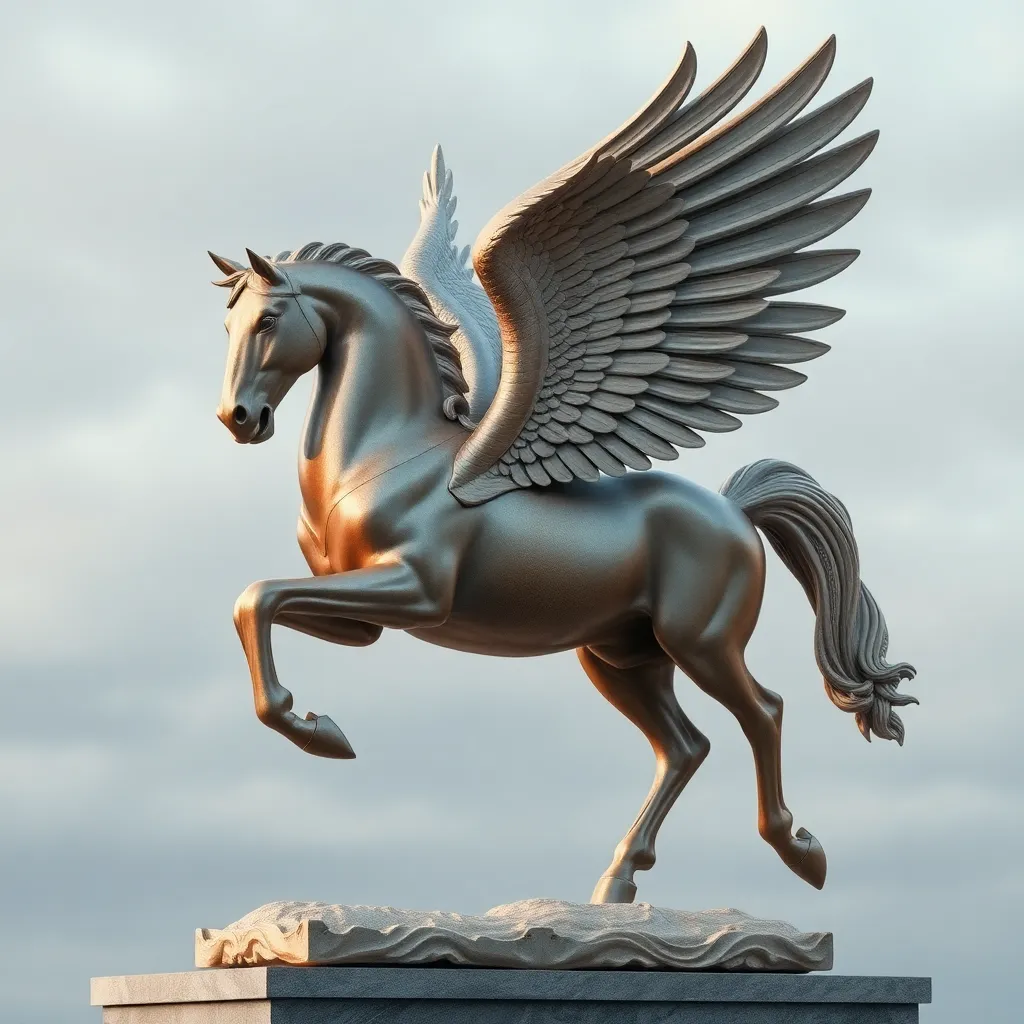Pegasus: The Winged Horse and Its Role in Greek Myths
I. Introduction
Pegasus, the magnificent winged horse of Greek mythology, stands as an iconic figure that captivates the imagination. Known for his majestic wings and ethereal beauty, Pegasus transcends the boundaries of mere myth to become a symbol of inspiration and creativity. His story intertwines with those of heroes and deities, enriching the tapestry of ancient Greek lore.
II. Origins of Pegasus
A. Birth from the blood of Medusa
Pegasus’s origins are as extraordinary as the creature himself. He was born from the blood of Medusa, one of the three Gorgons, who was beheaded by the hero Perseus. As Medusa’s blood touched the earth, Pegasus sprang forth, a creature of both terror and beauty, embodying the duality of life and death, creation and destruction.
B. Connection to Greek deities and heroic tales
Pegasus is not only a creature of myth but also closely linked to various Greek deities. After his birth, he flew to Mount Olympus, where he became a companion to Zeus, the king of the gods. He is often associated with the Muses, the goddesses of inspiration in the arts and sciences, reinforcing his role as a symbol of creativity.
III. Pegasus in Mythological Tales
A. The story of Bellerophon and the defeat of Chimera
One of the most famous tales involving Pegasus is that of Bellerophon, a hero who sought to tame the winged horse. With the help of the goddess Athena, Bellerophon was able to capture Pegasus and ride him into battle against the monstrous Chimera, a creature that breathed fire and terrorized the land. Together, they triumphed, with Bellerophon using Pegasus’s speed and agility to outmaneuver the beast and ultimately slay it.
B. The role of Pegasus in the adventures of Perseus
Pegasus also plays a significant role in the adventures of Perseus. After slaying Medusa, Perseus rides Pegasus as he ventures to rescue Andromeda, a princess who was to be sacrificed to a sea monster. With Pegasus’s assistance, Perseus defeats the monster and saves Andromeda, further solidifying the winged horse’s reputation as a noble and heroic companion.
IV. Symbolism of Pegasus
A. Representation of beauty and grace
Pegasus is often viewed as a symbol of beauty and grace, an embodiment of the idealized form of a horse with the added magnificence of wings. His image evokes feelings of freedom and transcendence, inspiring artists and poets alike to capture his essence in their works.
B. Association with poetry and the arts
Beyond his physical beauty, Pegasus is intrinsically linked to the arts. In ancient Greece, he was believed to have created the Hippocrene spring on Mount Helicon, which was said to inspire poets. Thus, Pegasus transcends his role as a mere creature of myth to become a muse for creativity and artistic expression.
V. The Legacy of Pegasus in Ancient Culture
A. Depictions in ancient art and literature
Pegasus has been a recurring figure in ancient art, depicted in sculptures, pottery, and frescoes. Artists sought to capture his dynamic form and ethereal nature, often portraying him in flight or alongside heroes. Literature, too, has celebrated Pegasus, with poets such as Hesiod and Ovid weaving his tale into their epic narratives.
B. Worship and temples dedicated to Pegasus
While there are no known temples solely dedicated to Pegasus, his presence in the worship of the Muses indicates his importance in ancient culture. The Muses were revered in various locations, often accompanied by imagery of Pegasus, representing the divine inspiration they bestowed upon poets and artists.
VI. Pegasus in Modern Interpretations
A. Influence on contemporary literature and pop culture
In modern times, Pegasus continues to inspire countless works of literature, film, and art. He appears in various adaptations of Greek myths, as well as in fantasy genres, where he symbolizes the eternal quest for freedom and adventure. His image often graces book covers, embodying the allure of the unknown.
B. Pegasus in advertising and branding
The image of Pegasus has also found its way into advertising and branding. Companies utilize the iconic winged horse to evoke feelings of aspiration, creativity, and elegance. For instance, the Mobil Oil logo featuring Pegasus emphasizes speed and reliability, showcasing how the mythological creature transcends time and industry.
VII. Comparative Analysis with Other Mythical Creatures
A. Similarities and differences with other winged beings in mythology
Pegasus shares similarities with other winged creatures in mythology, such as the griffin and the sphinx. However, unlike these creatures, which often have a more monstrous or hybrid nature, Pegasus embodies purity and grace. His uniqueness lies in his role as a companion to heroes, rather than as a guardian or adversary.
B. The unique place of Pegasus in the pantheon of Greek mythology
Pegasus occupies a distinct position in Greek mythology, revered not only for his beauty but also for his connections to divine inspiration. While many mythical creatures serve specific functions, Pegasus’s association with the arts and creativity sets him apart, making him a beloved figure in the cultural imagination.
VIII. Conclusion
Pegasus remains a powerful symbol in both ancient and modern contexts, representing the beauty of creativity, the spirit of adventure, and the pursuit of inspiration. His legacy as a winged horse not only enchants us with tales of heroism and valor but also inspires generations of artists and thinkers. As we continue to explore the realms of imagination, Pegasus will undoubtedly remain a guiding figure, reminding us of the boundless possibilities that arise from the realm of dreams.




